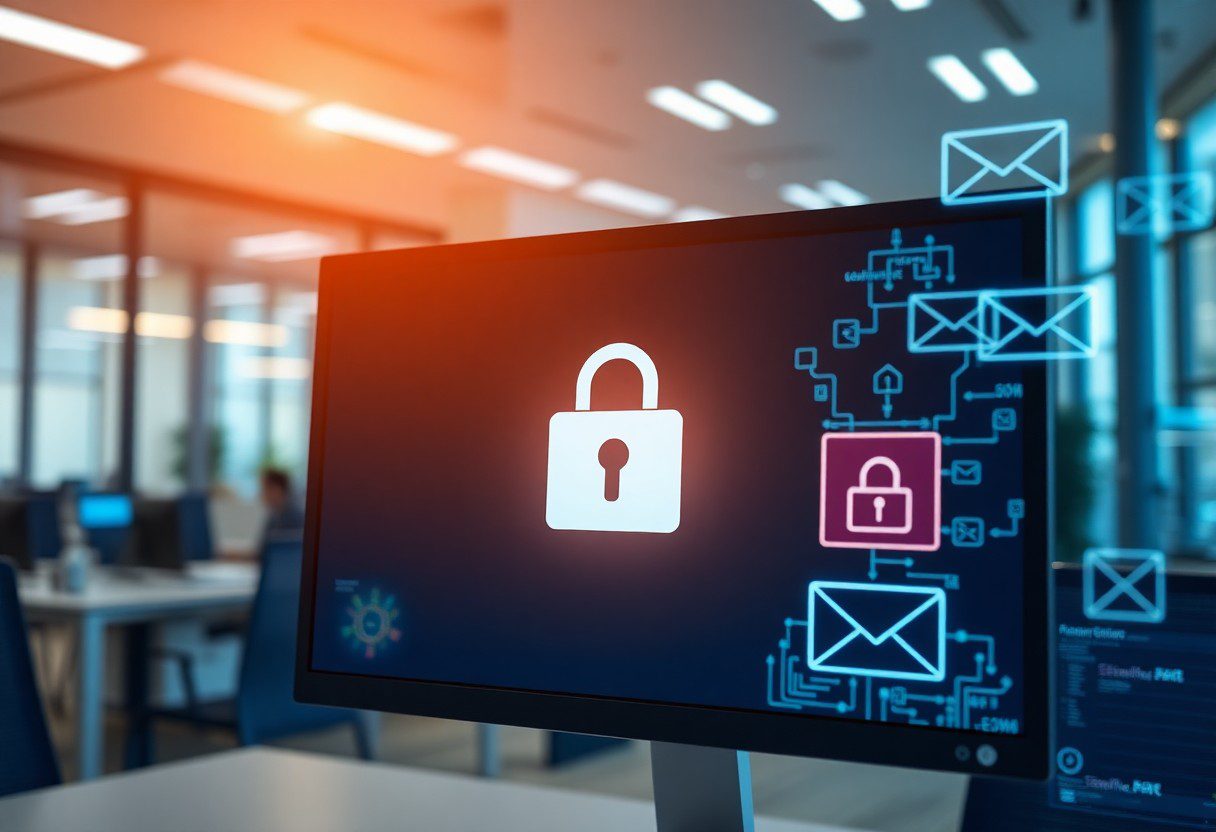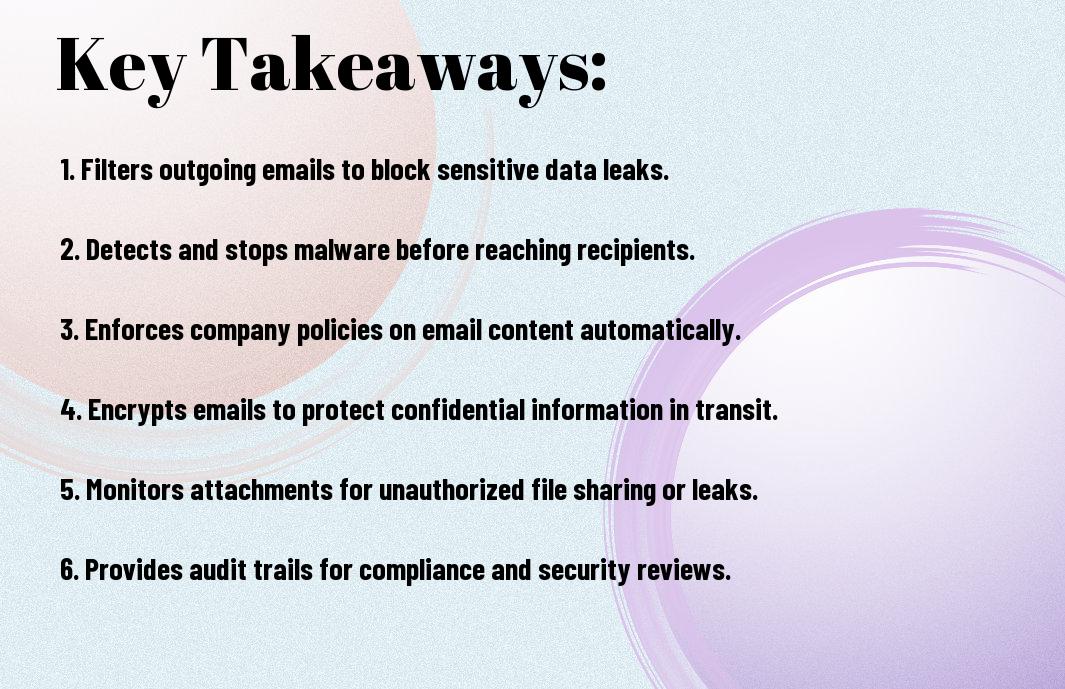Over recent years, the volume of sensitive information transmitted via email has escalated, making the protection of this data more important than ever. You may be wondering how a secure email gateway can fortify your defenses against potential data loss. By analyzing and filtering email traffic, these gateways provide an added layer of security that helps safeguard your confidential information from unauthorized access and malicious threats. In this post, you’ll discover the key ways a secure email gateway can enhance your organization’s data protection strategy.

Key Takeaways:
- A Secure Email Gateway can filter and block sensitive data from being transmitted through email, reducing the risk of unintentional data loss.
- Implementation of policy-based controls allows organizations to set specific rules about what data can be sent or received via email.
- Real-time monitoring features enable organizations to track email communications and identify potential data breaches or compliance violations immediately.
- Encryption capabilities ensure that sensitive information remains protected when being shared externally, mitigating data theft risks.
- Integration with existing security infrastructure enhances overall data protection, creating a layered defense against data loss events.
The Cybersecurity Threat Landscape: A Perfect Storm
The rapid evolution of the digital world has created a precarious cybersecurity landscape, with a potent combination of increasing connectivity, sophisticated technology, and a relentless surge in cybercriminal activities. Organizations face threats from various vectors, including insider threats, ransomware attacks, and data breaches that exploit vulnerabilities in their systems. As remote work becomes the norm and cloud-based applications proliferate, the attack surface widens, making it easier for attackers to infiltrate your defenses.
The Rise of Email as a Target
Email has emerged as one of the most exploited entry points for cyber attackers, primarily due to its ubiquity in business communications. Over 90% of cyberattacks involve phishing tactics, making email a prime target for malicious actors. This trend not only highlights the vulnerability of individuals but also signals a need for enhanced security measures to protect sensitive information exchanged through this critical channel.
Common Malware and Phishing Tactics
Many successful cyberattacks now leverage advanced malware and phishing techniques that play on human psychology. Common tactics include deceptive emails that impersonate trusted sources and contain malicious links or attachments. For instance, business email compromise (BEC) scams have led to losses exceeding $1.8 billion globally, as unsuspecting recipients transfer funds or reveal sensitive information, believing they’re responding to legitimate requests.
Your organization must stay vigilant against an array of phishing strategies, including spear phishing, where attackers tailor messages to specific individuals, increasing the likelihood of a successful breach. Additionally, variations like whaling target high-profile executives, while ransomware often follows malicious links disguised as enticing offers. Recognizing these tactics empowers you to implement protective measures, including employee training and deploying advanced email security solutions to mitigate risks.

How Secure Email Gateways Function: A Multifaceted Approach
Secure email gateways (SEGs) employ a multidimensional strategy to safeguard your organization’s email communications. By integrating various defensive mechanisms, they create a robust shield against data loss while ensuring regulatory compliance. This comprehensive approach includes filtering, encryption, and continuous monitoring, thereby addressing various threats in real-time. Your email data is continuously analyzed to detect abnormalities and protect sensitive information efficiently.
Advanced Threat Detection Mechanisms
Advanced threat detection mechanisms are vital for identifying and neutralizing emerging risks. These systems utilize machine learning and artificial intelligence to scrutinize email traffic for signs of phishing, malware, and other malicious content. Predictive analytics helps you stay one step ahead of any threats, ensuring your organization remains secure.
- Machine learning algorithms analyze historical data patterns.
- Real-time scanning of incoming and outgoing emails.
- Behavioral analysis to detect unusual activities.
- Integration of threat intelligence feeds for updated information.
| Component | Description |
| Heuristic Analysis | Detects anomalies by comparing email behavior to established patterns. |
| URL Filtering | Blocks potentially harmful links within emails before they reach your inbox. |
| Sandboxing | Isolates suspicious attachments to analyze them in a safe environment. |
Encryption and Data Loss Prevention Features
Encryption and data loss prevention (DLP) features play a vital role in securing your sensitive information. By encrypting email content, you ensure that data remains confidential, even if intercepted. DLP technologies monitor data flows and enforce policies that prevent unauthorized sharing or leakage of critical information.
In practice, encryption protects your email communications by using algorithms that make the content unreadable to unauthorized recipients. For instance, even if a malicious actor gains access to your email, without the decryption key, they cannot obtain any valuable data. DLP features work by analyzing the content of outgoing emails and applying pre-defined rules to automatically block, quarantine, or alert you about sensitive data being sent improperly. This combined approach significantly reduces the risk of data breaches while reinforcing your organization’s overall security posture.
Real-World Applications: Success Stories of Data Loss Prevention
Organizations around the globe have successfully implemented secure email gateways, showcasing their effectiveness in preventing data loss. For example, a major healthcare provider integrated a secure email solution that blocked over 4,000 phishing attempts within the first month, safeguarding sensitive patient information. In another case, a financial institution saw a 50% reduction in data breaches after adopting an advanced gateway system, illustrating the tangible benefits of proactive security measures against evolving threats.
Organizations Reinforcing Security Posture
Businesses are increasingly turning to secure email gateways to bolster their cybersecurity efforts. A technology firm, for instance, adopted a multi-layered email security approach, combining advanced threat protection with compliance features. As a result, they effectively safeguarded client data and improved overall trust and reliability in their services, demonstrating that a robust security posture can enhance customer confidence and protect your organization’s reputation.
Metrics of Success: Quantifying Reduced Incidents
Quantifying success in data loss prevention often involves analyzing specific metrics. Organizations that implemented secure email gateways have reported reduced incidents of data breaches by as much as 75%. These metrics not only highlight the immediate benefits of the technology but also underscore its long-term advantages for maintaining regulatory compliance and safeguarding sensitive information.
Providing compelling metrics can be pivotal when evaluating the effectiveness of secure email gateways. For instance, a recent study found that companies utilizing these systems experienced an average 60% decrease in incidents of data leakage and a 45% decline in phishing-related attacks. Additionally, many organizations noticed significant cost savings linked to mitigating risks, with estimates suggesting that prevention was far less expensive than the repercussions of a data breach. This compelling data reinforces the importance of sophisticated email security infrastructures in a risk-averse environment.

Building a Multi-Layered Security Strategy: Integrating Secure Email Gateways
Incorporating secure email gateways into your security framework strengthens your defense against data loss. A multi-layered strategy allows you to leverage the unique strengths of SEGs alongside other security mechanisms, creating robust barriers against evolving threats. This integration not only enhances data security but also streamlines incident response processes, ensuring that your organization is better prepared against potential breaches.
Complementary Technologies for Holistic Defense
Employing complementary technologies amplifies the effectiveness of secure email gateways. Solutions such as data loss prevention (DLP) tools, endpoint security software, and intrusion detection systems work in tandem with SEGs to provide comprehensive coverage. By integrating these technologies, you create a layered defense that addresses various vulnerabilities, leaving less room for attackers to exploit.
Employee Training and Awareness Programs
Enhancing employee awareness and offering training programs are key components in strengthening your overall security posture. Regular training sessions can empower your workforce to recognize potential threats, such as phishing attempts or suspicious emails, thus reducing the risk of data loss stemming from human error.
Effective employee training should encompass practical scenarios and simulated attacks to foster a better understanding of potential threats. Incorporating engaging methods such as interactive workshops and frequent updates on the latest security trends keeps your team informed and vigilant. By establishing a culture of security awareness, your employees become the first line of defense, significantly lowering the chances of data loss incidents caused by negligence or oversight.
The Future of Secure Email Gateways: Innovation on the Horizon
As technology evolves, secure email gateways (SEGs) are at the forefront of innovation to enhance email security. Advanced artificial intelligence and machine learning algorithms are set to transform how SEGs analyze and mitigate potential threats. Cloud-based solutions and integration with other security technologies will enable real-time protection and more comprehensive data loss prevention strategies. Companies that leverage these innovations will find themselves better equipped to handle increasingly sophisticated cyber threats.
Trends Shaping the Evolution of Email Security
Modern email security is increasingly influenced by the rise of remote work and mobile communications. The integration of machine learning for threat identification and the adoption of zero-trust models are reshaping the landscape. Expectations for user-friendly interfaces and automated threat responses are driving companies to enhance their email security protocols, ensuring that both security and efficiency remain top priorities.
Preparing for Emerging Threats in Digital Communication
Staying ahead of emerging threats in digital communication requires vigilance and adaptability in your email security practices. As cybercriminals deploy more refined techniques—such as social engineering and ransomware—investing in education for your employees becomes important. Regular training on identifying suspicious emails, coupled with continuous updates to your SEG’s threat detection capabilities, will fortify your defenses against evolving attack vectors.
Implementing a robust security awareness program can effectively mitigate the risk posed by social engineering tactics. Regular training sessions can guide your employees on recognizing the signs of phishing attacks and other malicious attempts, reducing the likelihood of human error. Furthermore, incorporating threat intelligence feeds into your SEG will empower it to adapt to new attack patterns, allowing it to proactively intercept potential threats before they reach your inbox. By building a culture of security awareness alongside technological advancements, you position your organization to thwart the evolving landscape of email threats.
Final Words
Upon reflecting on how a Secure Email Gateway can help prevent data loss, you can see its vital role in safeguarding your sensitive information. By filtering and monitoring email traffic, it ensures that phishing attempts and malicious attachments are blocked before they reach your inbox. Implementing such a gateway protects your organization from potential breaches and enhances your overall security posture. For more insights, explore this article on Secure Email Gateway: Essential Protection for Modern Businesses.
FAQ
Q: What is a secure email gateway and how does it function to prevent data loss?
A: A secure email gateway is a specialized email server that is designed to filter and manage email traffic to protect networks from various threats. It leverages advanced filtering technologies to scan inbound and outbound emails for potential data loss risks, such as sensitive information transmission. By enforcing policies, it can detect unauthorized sharing of confidential information, flagging or blocking emails that may pose a risk to data security.
Q: What types of data loss does a secure email gateway help to mitigate?
A: A secure email gateway assists in preventing a variety of data loss situations, including accidental email leaks, sabotage, and phishing attacks. It helps in monitoring outgoing emails for sensitive information, such as personal identification details or proprietary business data. By applying data loss prevention (DLP) policies, the gateway can prevent unintentional sharing or leaking of this information.
Q: Can a secure email gateway be customized to fit specific organizational needs?
A: Yes, secure email gateways typically offer customizable settings to adapt to the distinct needs of an organization. Admins can implement tailored rules and policies based on compliance requirements or specific operational protocols. This flexibility allows organizations to enforce different levels of protection depending on the sensitivity of the information being exchanged, ensuring a better fit for their unique requirements.
Q: How does a secure email gateway enhance compliance with regulations?
A: A secure email gateway supports compliance with various data protection regulations, such as GDPR, HIPAA, and others by enabling organizations to manage how sensitive information is sent and received. These gateways typically come equipped with reporting and auditing features that help organizations demonstrate due diligence in protecting data and complying with legal obligations related to data handling and privacy.
Q: What are the key benefits of deploying a secure email gateway for data loss prevention?
A: Deploying a secure email gateway offers several benefits for data loss prevention, including real-time monitoring of email traffic, effective filtering of malicious content, and the enforcement of data handling policies. Beyond protecting sensitive information, it helps in maintaining organizational integrity, minimizing risks of reputational damage, and ensuring operational continuity by preventing data breaches.

